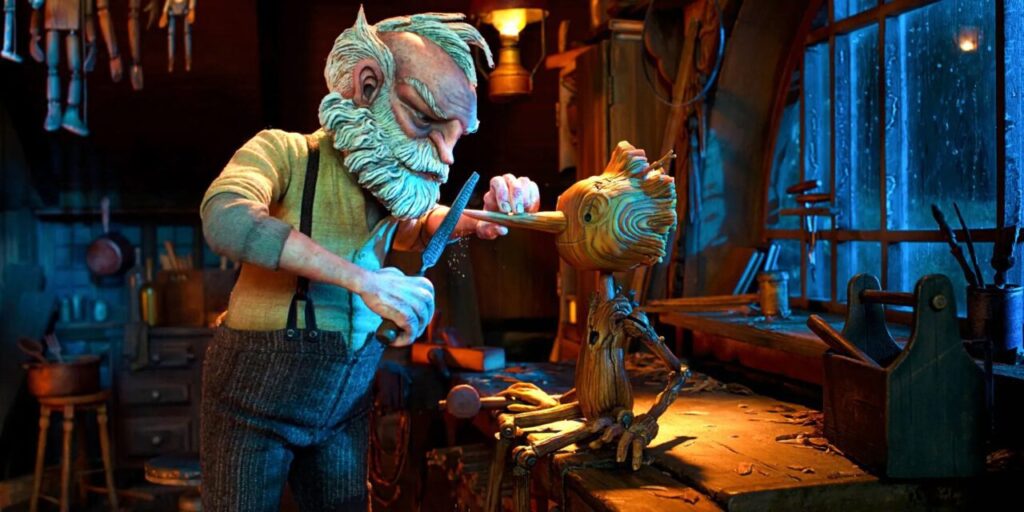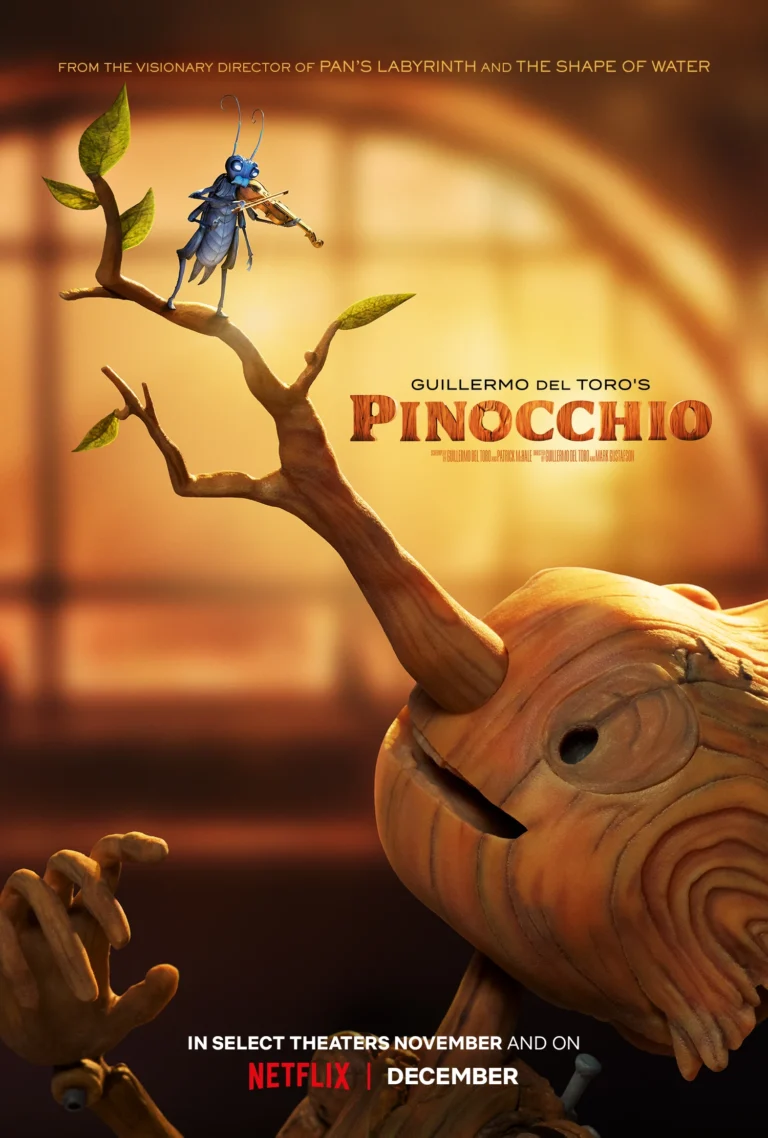Guillermo del Toro’s Pinocchio – Snapshot
Guillermo del Toro’s Pinocchio is a superb example of stop-motion animation, but it falls short as a musical and doesn’t tell a story most audiences will enjoy. (2.5*)
Where to Watch:
Stream: Netflix
Rent: ???
(Note: This isn’t a film for small children at all. And while age appropriate, I’m not sure older children will like this movie either!)
Guillermo del Toro’s Pinocchio – The Oscar Buzz
Oscar Nominations:
Animated Feature Film (WINNER)
Guillermo del Toro’s Pinocchio received a single nomination for Animated Feature Film, putting it in our “special interest” list. And it won the Oscar!
Guillermo del Toro’s Pinocchio – The Movie’s Family Tree
The Following Movies Share Talent with This One (and if you like these films, you might like this one):
The Shape of Water (17): Director (del Toro); Composer (Desplat); Production Design (Davis)
Nightmare Alley (21): Director (del Toro); Production Design (Davis); Acting (Blanchett)
Pan’s Labyrinth (06): Director (del Toro)
Hellboy (04)/Hellboy II: Director (del Toro); Acting (Perlman)
Isle of Dogs (18): Composer (Desplat); Production Design (Davis); Acting (Swinton)
Guillermo del Toro’s Pinocchio is aptly titled because this is definitely his interpretation of the nearly century-old story. Del Toro always applies his own quirky style to his works as you can tell if you’ve seen any of the first four films above. For his version of the Pinocchio story (and his first animated feature film) he chose to work with stop-motion animation and was able to attract artists that had previously worked on films like Coraline and ParaNorman. Although he takes the technology to what might be its natural limits, the film does seem to share a lot with a previous animated feature, Wes Anderson’s Isle of Dogs.
Guillermo del Toro’s Pinocchio – What Others Think
Guillermo del Toro’s Pinocchio may have won the Oscar, but both the viewing public and the critics put this in the middle of this year’s animated films. Carlos Aguilar (RogerEbert) was enthralled with “the superb crafsmanship in every detail of the characters that inhabit this darkly whimsical realm.” He concludes “If the art of making movies resembles magic, this is one of its greatest incantations.” James Berardinelli (ReelViews) enjoyed the story and contrasted it to Disney’s 1940 version, “While Disney did minor pruning to make the story palatable to mass audiences, del Toro goes beyond that, crafting a tale that is sufficiently different from any predecessors to warrant its existence.” And Nick Bradshaw (Sight&Sound) raves calling it “…a marvelously rich and lively caliber of animation, a soaring interplay of lighting and camerawork and puppetry that raises the bar for the expression of character and action in this style.”
But there were some negatives as well. Manohla Dhargis (New York Times) concluded “the movie’s decontextualized and disturbingly ill-considered use of Fascism is reductive and finally grotesque.” And I’m not the only one that found the attempt to turn this into a musical unsuccessful. Berardinelli concluded his review “If there’s one negative, it’s the pointless and forgettable songs (nine of them) that seek to add a musical element to a movie that would have been far better without them.” (I have more to say about these themes below.)
Guillermo del Toro’s Pinocchio – Special Mention
Stop Motion Animation – There are many ways to make an animated picture, but one of the most difficult and time consuming is through what’s called stop-motion. In a stop-motion picture puppets of some kind are used instead of drawings because it produces an immediate three-dimensional look and feel. But, in order to produce motion, the puppets must be moved in tiny increments, reset in the staged background and then photographed. The process is repeated in painstaking detail until all the pictures necessary to produce a movie (at 24 frames/second) is completed. There are literally thousands of individual still photographs each just barely different than its predecessor in order to simulate motion.
For Guillermo del Toro’s Pinocchio, they introduced additional technology – 3-D printing. Pinocchio’s face in any given scene is picked from one of 3000 different 3-D prints, each with a slightly different facial expression. When added to his wooden puppet body, the effect is to give a staggering realism to his movements. Work on the filming required months of excruciatingly detailed and repeated movement of different sized physical models interacting with each other. No wonder the filming process itself took forever.
The Pinocchio Story in Film – This isn’t the first Pinocchio I’ve reviewed and it certainly isn’t the first movie to render the story. Written originally as a magazine serial in the mid 1800s by Italian Carlo Collodi, it was apparently intended as a morality tale designed to scare children into behaving. It showed a big world out there that was not at all nice and children needed to learn caution. Interestingly, Collodi originally killed off his Pinocchio in a gruesome hanging. Whereas in this film, Carlo is the name of Gepetto’s real son and del Toro kills him off shortly into the movie.
The story has been made into countless big screen and TV movies including the original Disney version from 1940 and a live action remake, also by Disney, that came out just after this one! But the one I reviewed, Pinocchio (19), was a live-action version, that received costume and makeup nominations, from Italian director Matteo Garrone. Despite some great cinematography and acting from Oscar-winning Roberto Benigni, I found the story “disjointed” and that “it wasn’t executed with the proper attention, feeling and care.”
Guillermo del Toro’s Pinocchio – Michael’s Moments
Guillermo del Toro’s Pinocchio, is, like many of del Toro’s other works, a highly personal interpretation. I suspect that, to him, everything about it makes perfect sense. But I can’t help but wonder if he ever answered the all-important question of who, exactly, was his audience supposed to be? And does the film make sense to them?
To be sure, del Toro is known for producing unusually interesting movies, most of them I really liked – The Shape of Water, Nightmare Alley, and Pan’s Labyrinth were all terrific films. He portrays characters, especially those that are alien or marginal, with both tempered fascination and genuine empathy. He infuses his stories with a measured amount of twist and mystery that sustains interest. And, finally, he always demonstrates a high level of craftsmanship.
In Guillermo del Toro’s Pinocchio, all of those features are evident, and, as already noted, his use of stop-motion brings the art up to nearly perfect levels. But in this movie, perhaps del Toro hasn’t fully solved the problem of establishing and respecting his audience. What was the point, for example, of including nine basically forgettable songs? Despite music by two-time Oscar winner and nine-time-Oscar-nominated Alexandre Desplat, the songs fall flat. Sure the characters sing them, but the music adds nothing to their character development, nor to the story-line. Perhaps del Toro was trying to show how he has masterfully adapted stop-motion to the musical genre, but the music adds only length to the movie.
Then there are two fairly significant side themes del Toro thought important enough to include in the story, although they aren’t in the original Pinocchio at all. One is the ongoing reference to fascism. Criticizing fascism isn’t exactly a hard thing to do, but what was important about it to Pinocchio? I get that a boy, even a wooden one, would always have issues with obedience, but why carry it to the point of Mussolini? Is del Toro trying to give us a lesson in how Freudian obsessions with father-figures get transmuted to political dictators? Who needs that lesson, really, or is this just one of del Toro’s pet issues? There is a similar extraneous issue related to del Toro’s apparent estrangement from his Catholic faith, reflected in his very ambivalent treatment of the priest and the crucifix.
Ultimately, the problem with Guillermo del Toro’s Pinocchio is that del Toro lost sight of who his audience is. I have a hard time understanding exactly who is going to enjoy this film. It won’t be children because they won’t be interested in the religious and political themes. And it likely won’t appeal to adults because, well, who really needs another Pinocchio movie. I suppose a few stop-motion animation lovers will be enthralled with his craftsmanship. In the end, it seems del Toro made this film just for himself. Hmm. He kind of said that in the title, didn’t he? (2.5*)


